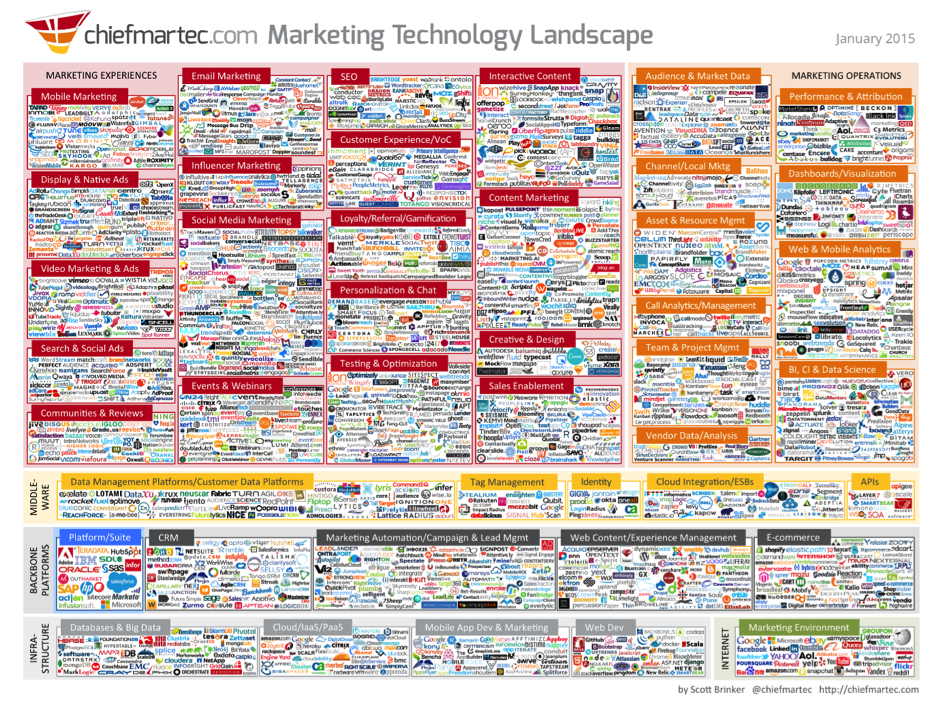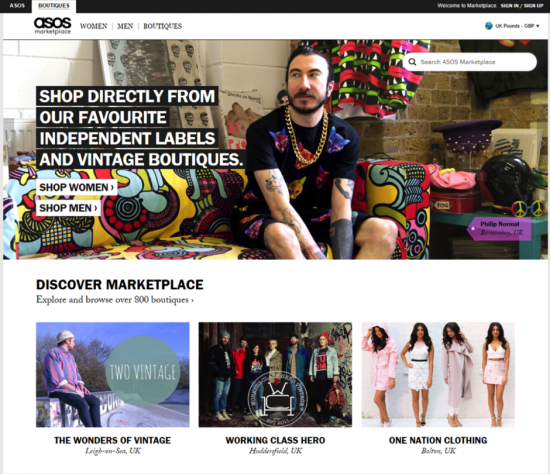The power of branding in the multi-channel retail world
Victor Hugo once said that “no army can withstand the strength of an idea whose time has come”. In many ways brands can be equally as powerful, inspiring loyalty, love and of course sales! However it’s easy for companies to overlook the power and value of their brands in the frantic search for smarter technology and smarter ways of doing business.
Good branding holds the key to cutting through an increasingly fragmented media landscape to ensure a product is front of mind at the moment a consumer decides it is time to buy.
Outlined below are a few tips on branding in today’s more complex and fast moving world.
Enough with the complexity already!
In Scott Brinkers Marketing Technology Landscape Supergraphic below we see a bewildering array of different marketing technology vendors but what’s striking here is that each of these companies represent a technology that is actually designed to simplify your marketing activity.
If this image represents an industry aimed at simplification then it neatly illustrates the point that complexity is one of the biggest challenges facing businesses. It’s also a challenge for individuals and research suggests that as consumers we see between 500 and 3000 logos per day (so this diagram has just upped your weekly average).

In a world of so much complexity, unless your brand is at the heart of everything you do then your message will simply get drowned out by the white noise of media and competing demands for attention.
Speed Kills
One of the reasons that attention is in short supply is speed. As we know speed kills but these days its killing off those businesses that can’t keep up. Some even believe that speed is killing off the very concept of strategic planning. Proponents of the agile, lean-start up mentality argue that rapid responsiveness beats overly analytical strategy any day of the week.
While planning may be unlikely to truly die we’re certainly looking at a shorter planning horizons of 3 rather than 5 years. As a result it is more important than ever that everyone who is along for the ride has a clear understanding of what the brand stands for if they are going to have a hope of making the right decision making on the fly.
Some tips on branding
So how can companies harness the power of their brands? Outlined below are some guiding principles for brands in this new era of communication.
1. Keep it simple - focus
Nick Robertson, CEO of ASOS recently said that the pivotal moment in his business’ history was when they decided that they were going to do nothing else other than sell fashion to twenty something’s. Once he’d made the decision it became easy to align everything about the business behind this simple brand goal. This focus on twenty somethings goes right the way through the organisation with the majority of people who work at ASOS team being in their twenties and so living and breathing the lifestyle typified by the brand.
Compare that with Tesco which has struggled of late to clearly define itself on the shifting sands of changing consumer tastes and buying behaviours. As a result it’s seeing intense competition both at the top by the likes of Waitrose and at the bottom buy the likes of Aldi and Lidl, who have a clear focus and know their audience well.
2. Keep it simple (2) - message
We’re living in the age of impatience so brands shouldn’t expect people to spend time working out what it is you are trying to say. Getty Images founder and CEO Jonathan Klein Getty recently said that “imagery is the fastest growing language on earth”. His company has done very well out of this as companies look to their visual language to simplify a thousand words into a single picture.

3. Your brand = user experience
A few years ago Oxo decided that it wanted to create a distinctive range of products where usability was central to the brand. They took a number of everyday products like the potato peeler and applied usability design to launch the Good Grips range of products that gave a radically different user experience to other alternatives.
What we’re seeing now is the same thing is happening online as companies have woken up to the competitive advantage that a great user experience can bring. Amazon’s customer’s loyalty stems more from the fact that it is an effortless way to buy rather than any affinity that its customers may have to what the brand stands for.
New innovations such as Apple Pay mean organisations can now start crafting simple omni-channel user journeys that can travel seamlessly from online to instore building loyalty through delivering great experiences. Successful brands of the future will ensure that they make themselves irresistibly useful in their consumer’s lives.

4. If you don’t stand for something, you’ll fall for anything.
Despite its great user experience, something Amazon increasingly struggles with are negative perceptions of its corporate ethics particularly around issues such as tax and employment. Today’s consumers demand higher standards from brands and prefer to give their money to those organisations that can do well from doing good.
So to stay relevant and be considered, a brand should stand for something that is authentic and relevant that goes beyond the marketing message. This may come from a visionary leader, a brand’s heritage, core values or even its audience but ultimately a business’ ethics can no longer just be about ticking the CSR box.
Interestingly in some areas we’re witnessing a backlash against established companies with long-term experience because Generation Y has become disenfranchised with big institutions, politicians and authority. As a result they are often more likely to trust an independent YouTube reviewer or their friends than they are a major brand with decades of specialist experience.
5. Tone of action
With the transparency of the internet, what a brand does is now far more important than what a brand says. A great example of tone of action is IKEA’s refugee shelter project. The company’s IKEA Foundation worked with UN HCR to create flat pack shelters for refugees which revolutionised the existing accommodation provided by temporary tents. These new shelters have been designed to be cheap and are optimised for shipping, health, safety and comfort and can easily be put together with simple tools that are widely available throughout the world. The beauty of the initiative is that it shows they stand for something and they’re doing something about it, and of course it shows that they’re good at making things flat pack.


Photographer: Erik Hagman
Red Bull is another great example of this sort of deep branding. Most brands who want to be associated with F1 might sponsor a team by putting their logo on the car. Instead Red Bull has invested hundreds of millions of pounds to build and run a winning team.
6. Your brand = content strategy
If it’s done well, a great content strategy will weave together all the different threads and attributes of a brand into a stronger more cohesive whole. However a great content strategy, like a great brand, will aim to make consumers lives better in some way. Therefore mapping out the pain points in their customer’s lives and building content to help address these can make what you have to say useful and so ultimately welcome.
However really smart brands inspire their audiences to create their own content and then give them the tools to do so just as ASOS does with its look books and #AsSeenOnMe campaign.
7. Create a brand operating system
If we as marketers accept that brands no longer fully control the conversation then why not take this to its ultimate conclusion by enabling our audiences to take control of your brand and make their own stories and messages?
During the Obama presidential campaign an iconic brand campaign was created specifically to be adopted and reversioned by his supporters. It was this freedom to deconstruct and reconfigure the branding that gave his followers the ability create a grass roots movement that ultimately helped contribute to their victory.
A well-known example of this democratisation of a brand is Lego which as it turns out is not only the ultimate modular product but it is also the ultimate modular brand. There is an incredible amount of fan based content online from satirical stop frame photography to co-created new products.
To a degree, ASOS have done with this with their market places and have invited small boutique retailers who technically could be seen as competitors. In truth though ASOS is under no real threat and it simply enhances its authenticity as an edgy brand.

8. Emotional Cut Through
As we are inundated with 24 hour news and media saturation we are becoming increasingly immune to the background noise of brand communication and so to achieve cut through today’s brands are increasingly using emotion. Emotion can act as a rapid propellant for social media as people are more likely to share something that has moved the emotional needle simply because it touched them. Brands like Dove have done a great job of connecting in this way but it’s critical that companies are not seen as cynical or exploiting people’s goodwill.
9. Collaboration
As companies narrow their focus it opens up new opportunities for collaboration and strategic partnerships because it becomes easier for them to work together without stepping on each other’s toes. Companies that were previously competitors can work side by side to provide new experiences to consumer through novel combinations of complementary products and services.
IKEA and Airbnb recently collaborated on a project where the chance to stay overnight in an IKEA store was advertised through Airbnb.
At first glance there’s no obvious link between the two organisations but in fact both companies are well known for their innovative use of space and so the association is mutually beneficial.
Another great example of brand partnership is Uber and Spotify which apart from being highly disruptive have nothing obvious in common. However by working together to allow users to use their Spotify accounts in the back of taxi cabs they were able to not only differentiate the brand experience of an Uber cab but also create an interesting shop window and touchpoint for Spotify. By looking at the world with a completely different filter they have transformed the back of a cab into a place where they can sell all sorts of different products.
10. Brand = data
We’re at a fascinating point in the journey of branding where we’ll start to see a Darwinian approach to branding emerge as a result of the continuous optimisation that is possible through digital technology. It is now common practice to test, iterate and refine a website on a continual basis and while at present this is mainly concerned with conversion rate optimisation it presents the opportunity to test and evolve our core brand offering too. Therefore how we structure, capture and measure our data should reflect our brand drivers. This is enormously powerful in terms of what it means for the future of brand communication.
11. Dark Posts
We’re starting to see this level of personalisation become widely available and Facebook has now opened up its back end to advertisers. Facebook dark posts allow advertisers to segment their data and target their messages moving towards a 1 to 1 model of advertising.
Retailers themselves have been investing heavily in personalisation for example Shop Direct can now give customers a fully personalised homepage at Very.co.uk,
It expects this to add over £20m in sales and while the emphasis is on personalising the product and promotional offering there is also scope to refine the brand messaging too.
12. Brand = technology
At the Web Summit in Ireland last year Chris Satchell the Consumer Technology Officer at Nike made the point that your brand is your technology.
The team at Nike are looking to embed the values of their brand into their technology and coding this in at an intrinsic level. It’s easy to think that tech somehow exists in its own right but Nike see it as inherently at the heart of their brand.
13. Liberate your brand
It has been said that data wants to be free but it can also be said that brands want to be free. Companies need to liberate their brands from ivory towers so that everyone from the cleaner to the CEO lives and breathes the brand.
Ultimately in today’s multi-channel world the brand should be both the start and end point in terms of defining the customer experiences.

Thanks to
Jonathon Palmer for sharing their advice and opinions in this post. Jonathon is currently Strategy Director at digital commerce agency
Blueleaf and works with global retailers and brands to translate commercial ambition into market leading customer experiences. You can follow him on
Twitter or connect on
LinkedIn.









 Thanks to
Thanks to 



